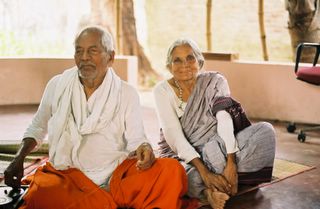What Color is Your Parachute?
I was immediately reminded of this on the plane over, on Jet Airways, an Indian airline. All the air hostesses serving the mostly Tamil passengers, whose skin color will vary from Nescafe to dark cocoa bean, were from Assam or Meghalaya, in far northeast India. The Assamese have extremely light skin, and some of the rounded facial features of the Burmese to the east. Peter tells me that the government once came up with a scheme to prepare young women for careers beyond those in which they are usually well accepted – teaching, and especially in the south, medicine and the health ancillary professions. They set up a training program to prepare Tamils to become airline stewardesses. Following graduation, not a single one was able to find employment in the industry.
My language skills are not strong enough to follow Tamil TV (though I enjoy the broad humor and slapstick), but I can always tell what is the show and what the commercials. The TV stars will be Tamils, easily identifiable. But all the advertisements, and especially the incessant ones for beauty products, will feature light-skinned beauties, who, with dress changed, might have stepped out of the pages of Glamour magazine. The drug stores do a booming business in skin-whitening products (one would be horrified by the ingredients). Marital ads in the newspapers feature caste, income, employment, and then an array of English adjectives for color (fawn, cream-colored, or just plain light-skinned) designed to make the bride seem more desirable. When you see married couples, it is almost inevitable that the wife will be lighter-skinned than her husband, at least among the monied classes.
This would not seem to have been an inevitability. Rama and his later incarnation Krishna are both supposed to be blue in color, signifying their darkness. Apparently, it wasn’t always so noticeable. When Sita choose her future husband out of a lineup, she chose Rama without regard to skin color, but rather noticed that his feet, like that of all god-figures, didn’t touch the ground. (Bhoomikumar reminds me that the fact that the flowers in the garland around his neck never drooped, and that he never blinks, was also a dead giveaway. Dark-skinned Krishna, whose skin is often compared to the blue of the sky at twilight, has no trouble attracting dozens of gopis – cow-maidens – once he starts playing on his flute. Lord Venkatesh, the god-figure at the Tirupati pilgrimage site, is totally blackfaced. One wonders whether color discrimination came to India among the many ills the British brought with them.
I am quite willing to make use of my western status and white-skin privilege when it can serve the cause. Folks do a double-take when, among the western dress of the government office clerks and the bank managers, they see me in my khadi (homespun) pajamas and kurta. (That it is much more comfortable has nothing to do with it – well, okay, a little.) And I will dive into the brickmaking – not that I am strong enough to really do much, but it is my way of insisting on the importance of the work.
I am still amused that when Meera, my Indian-born daughter (with relatively light skin) was talking with her Arabic professor from Jordan about her family’s long-standing connections to India and Africa, his comment was, “Well, it seems they are even more brown-skinned than we are.”
I can live with that.


0 Comments:
Post a Comment
<< Home